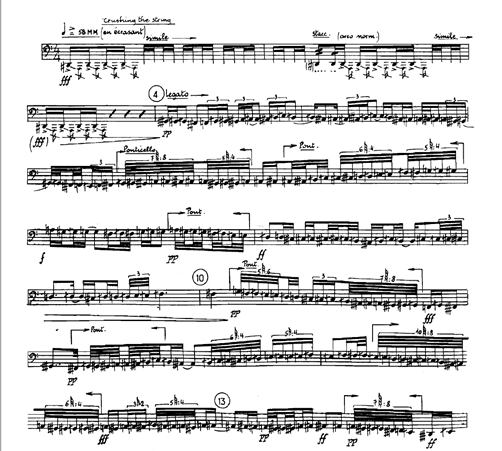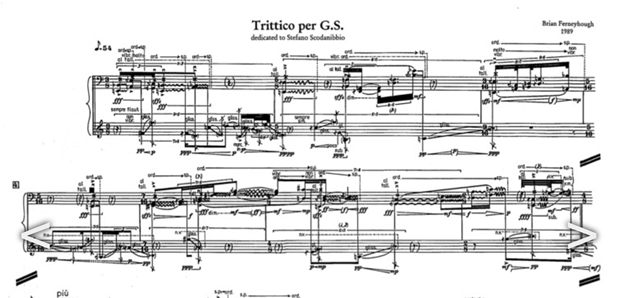Volume 17, June 2023
Learning Strategies for Complex Rhythms: Approaching Richard Barrett's splinter for contrabass solo (2018-2022)
by Kathryn Schulmeister
3. Trittico per G.S. and Theraps
Both Ferneyhough and Xenakis have composed significant solo works for the double bass, Trittico per G.S. (Ferneyhough, 1989) and Theraps (Xenakis, 1976). While both pieces pose tremendous challenges to the performer in terms of the rhythmic interpretation and technical virtuosity required to perform the demands of these works, the nature of how rhythmic ideas (temporal relationships) are conceptualized within each piece differ significantly. In Xenakis' Theraps (1976) for solo contrabass, Xenakis uses stochastic principals to generate varied tempi within the work, which he overlays on a consistent meter of 4/4 for most of the piece (see figure 1).5
Figure 1: Xenakis: Theraps (1976)for solo contrabass, measures 1-13
Xenakis creates a single musical line which morphs through acceleration and deceleration as it traverses the pitch range of the contrabass. Although the rhythmic material in Theraps is complex in that it frequently features bracketed polyrhythms within single measures, it doesn't necessarily relate to the traditional profile of the 4/4 meter (i.e., it doesn't favor traditionally strong or weak beats).6 I assert that Xenakis is rather using the 4/4 meter as a convenient method to create a consistently measured extended temporal canvas upon which to articulate varied tempi generated by his stochastic theory and expressed through polyrhythmic subdivisions of the beat.
In contrast, Ferneyhough's Trittico per G.S. (1989) for solo contrabass presents an approach to rhythm that is not concisely linear but rather complex in its superimposition of multiple layers of rhythmic lines that intentionally disrupt and interfere with each other, all written within rhythmic relationships to carefully constructed meters that vary nearly every measure (see figure 2).
Figure 2: Ferneyhough: Trittico per G.S. (1989) for solo contrabass, measures 1-7
In Trittico per G.S., Ferneyhough creates intricately sculpted rhythmic phrases within the inherited traditions of a metric framework. In the authoritative article on the performance of Ferneyhough's iconic solo percussion work, Bone Alphabet (1991-92), percussionist Steven Schick explains that Ferneyhough does not conceive of the rhythmic material within the work as constantly varying tempi. Consequently, Ferneyhough advised the interpretation process to not involve the translation of polyrhythmic ratios into tempo values as a learning method to solve the rhythmic challenges.
On this subject, Schick writes:
In my conversations with Ferneyhough, he has clearly indicated his opposition to such tempo-based solutions to polyrhythmic composites. He maintained that polyrhythms conceived as modulations of speed cause a reorientation of the strong and weak beats that lend metric sense to a given passage.7
Schick's insight and Ferneyhough's scores both suggest that an artistic interpretation of rhythm within a Ferneyhough score may be dealt with differently than how one interprets rhythm in a Xenakis score. Although some notable complex rhythm experts including Edwin Harkins insightfully point out that elements of meter, tempo, and rhythm are theoretically equally interchangeable in how they can be notated and intellectualized8, Ferneyhough's sentiment in his conversations with Schick and the clear intentions of the principles guiding the compositional processes of Xenakis and Barrett suggest there is room for nuanced and individualized approaches in building personal interpretations of these varied pieces. In other words, there are multiple strategies that could be employed to realize the rhythmic challenges of these works, and I argue that it's useful to consider the artistic inspirations and conceptual intentions of individual composers when deciding how to navigate the process of learning and performing their works.
|


